

GitHub - knolleary/pubsubclient: A client library for the Arduino Ethernet Shield that provides support for MQTT. ESPEasy - ESP8266 - Wiki. The ESP Easy firmware can be used to turn the ESP module into an easy multifunction sensor device for Home Automation solutions like Domoticz.
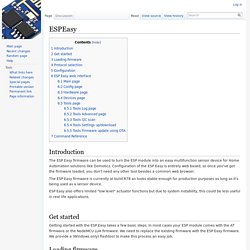
Configuration of the ESP Easy is entirely web based, so once you've got the firmware loaded, you don't need any other tool besides a common web browser. The ESP Easy firmware is currently at build R78 an looks stable enough for production purposes as long as it's being used as a sensor device. ESP Easy also offers limited "low level" actuator functions but due to system instability, this could be less useful in real life applications. ESPEasy - ESP8266 - Forum. Who is online In total there are 15 users online :: 2 registered, 0 hidden and 13 guests (based on users active over the past 5 minutes)Most users ever online was 197 on 19 Mar 2016, 13:11 Registered users: karel45, Mihadongle Legend: Administrators, Global moderators Birthdays No birthdays today.
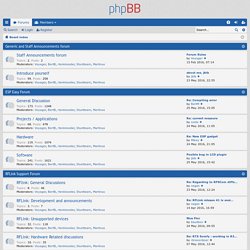
GitHub - wot-sdk/rtos-wot: Open source FreeRTOS SDK for ESP8266 WiFi Module. Adafruit HUZZAH ESP8266 breakout. Each HUZZAH ESP8266 breakout comes pre-programmed with NodeMCU's Lua interpretter.
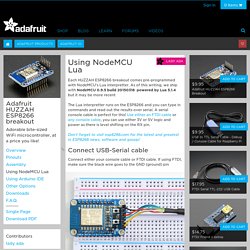
As of this writing, we ship with NodeMCU 0.9.5 build 20150318 powered by Lua 5.1.4 but it may be more recent The Lua interpretter runs on the ESP8266 and you can type in commands and read out the results over serial. A serial console cable is perfect for this! Use either an FTDI cable or any console cable, you can use either 3V or 5V logic and power as there is level shifting on the RX pin. ESP8266 Temperature / Humidity Webserver.
The ESP8266 based wifi breakout boards are becoming more popular with Makers due to a low cost and a powerful, programmable microcontroller on-board.
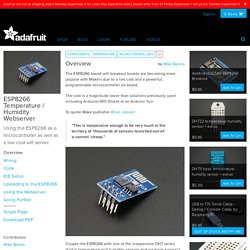
The cost is a magnitude lower than solutions previously used including Arduino+Wifi Shield or an Arduino Yun. To quote Make publisher Brian Jepson: “This is inexpensive enough to be very much in the territory of ‘thousands of sensors-launched-out-of-a-cannon’-cheap.” Couple the ESP8266 with one of the inexpensive DHT series digital temperature and humidity sensors and we have a project that may literally be deployed anywhere to broadcast sensor data. The broadcasting used in this tutorial is using the ESP8266 web server code and respond to web requests (like in a browser or a web client) to return temperature and humidity data (in a REST type format). ESP8266 powered web server + LED control + DHT22 temperature/humidity sensor reading.
[Edit] Make sure to check my much more advanced example here The ESP8266 System-on-chip (SoC) has recently came out of nowhere and has been taking by storm the IoT DIY world.

It is a $4.50 Wi-Fi capable chip that has remarkable specs, obsoleting overnight a number of similar products that are out there. The price factor, availability of SDK and a fast growing community make this chip quite attractive. The most common usage for the chip so far has been to interface it to MCU and utilize the AT commands that are available in the default firmware, however that is quite an abuse of the power under the hood of the ESP8266. I’ve decided not to use external MCU and utilize the chip itself for a proof-of-concept project: The project shall be able to There are few different versions of the breakouts available, most popular is the DIP version . The SMD version is more interesting, as more of the GPIO pins are available: Adafruit/ESP8266-Arduino.
En:d1_mini [WeMos.cc] View topic - My Espressif DevKit for Windows + Eclipse IDE. - Fri Dec 12, 2014 4:17 am#4639 Hi Based on a series of my articles I publish my assembly Espressif DevKit for developing firmware on Windows, all further discussion propose to write here.

Article on the assembly firmware. ESP8266 WIFI module. I just got a ESP8266 WIFI module I ordered a few weeks ago.
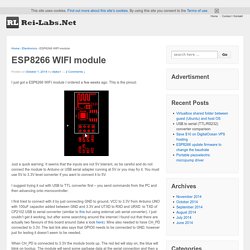
This is the pinout: Just a quick warning: It seems that the inputs are not 5V tolerant, so be careful and do not connect the module to Arduino or USB serial adapter running at 5V or you may fry it. You must use 5V to 3.3V level converter if you want to connect it to 5V. I suggest trying it out with USB to TTL converter first – you send commands from the PC and then advancing onto microcontroller.
I first tried to connect with it by just connecting GND to ground, VCC to 3.3V from Arduino UNO with 100uF capacitor added between GND and 3.3V and UTXD to RXD and URXD to TXD of CP2102 USB to serial converter (similiar to this but using external usb serial converter). When CH_PD is connected to 3.3V the module boots up. If you got the “ready” message you can send a test command “AT\r\n” or maybe “AT+RST\r\n” to see the module responding.
You can check the working mode by command AT+CWMODE? Wi07c - ElectroDragon. Specification.
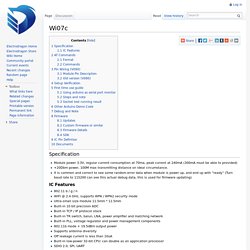
WiFi Serial Transceiver Module. In this tutorial, we'll use a seeeduino to control the ESP8266 WiFi module to request a static page from the internet.
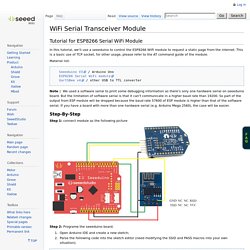
This is a basic use of TCP socket, for other usage, please refer to the AT command guide of the module. Material list: Seeeduino V3 / Arduino Uno ESP8266 Serial WiFi module UartSBee v4 / other USB to TTL converter Note: We used a software serial to print some debugging information as there’s only one hardware serial on seeeduino board. But the limitation of software serial is that it can’t communicate in a higher baud rate than 19200. Millions of Prototyping Components Online! View forum - Arduino. ESP8266 WiFi module. ESP8266 WiFi SoC has gained enormous popularity in the nick of time.

Right after hackaday introduction dedicated community forum was created despite that first batch of modules was still in shipping so virtually no one had it in hands. The key to success was its price - $5 or even less, including shipping fee. That's significantly cheaper than e.g. ESP8266 - NURDspace. "File:" cannot be used as a page name in this wiki. Building the gcc toolchain have a look at the github wiki Code examples Running the module. ESP8266. Note: This page contains information on using an ESP8266 module with an Espruino board. If you want to run the Espruino Firmware directly on an ESP8266 board, see this page instead Support is provided in Espruino by the ESP8266WiFi (About Modules) and ESP8266WiFi_0v25 (About Modules) modules.